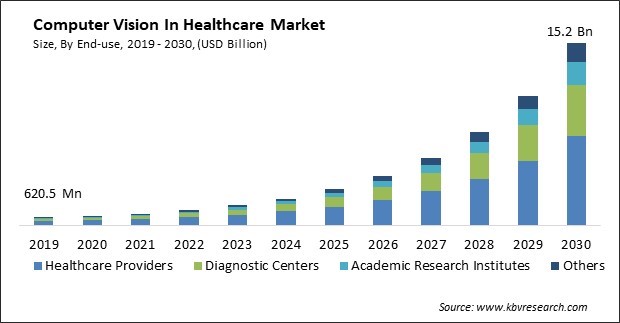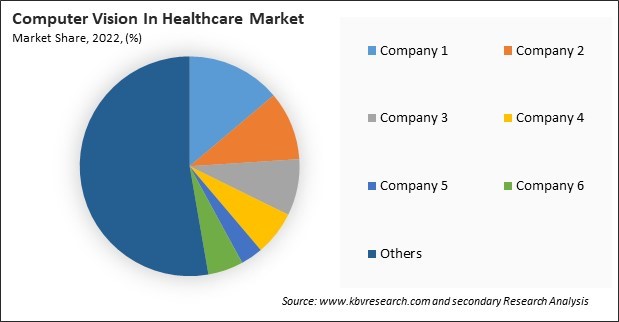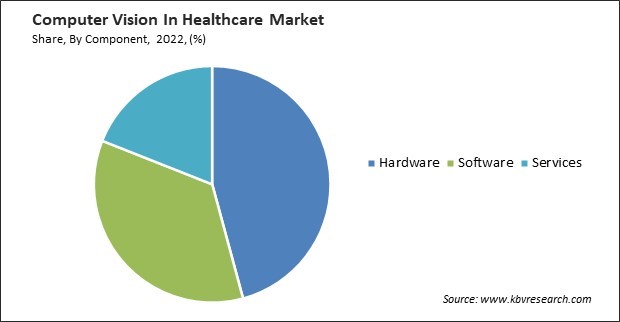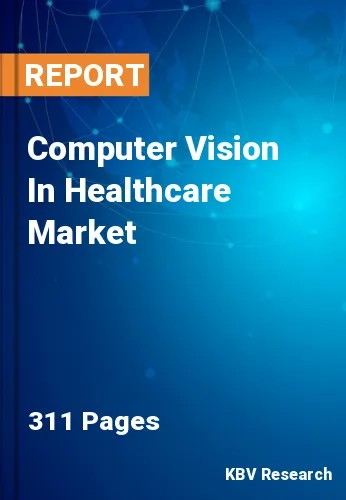The Global Computer Vision In Healthcare Market size is expected to reach $15.2 billion by 2030, rising at a market growth of 37.3% CAGR during the forecast period.
Developing and modernizing their healthcare infrastructure is a priority for many Asia-Pacific nations. Thus, the APAC region registered $329.3 million revenue in the market in 2022. There are opportunities to incorporate computer vision technologies to improve healthcare services when creating new clinics, hospitals, and diagnostic facilities. A sizeable portion of the world's population resides in Asia Pacific, where chronic diseases are more common. Innovative technologies, such as computer vision, are required to support diagnosis, treatment, and patient management due to the growing demand for healthcare and the large patient population. Some of the factors impacting the market are rising advancements in imaging technology and data availability, growing global health challenges like aging population, and lack of standardization.

The sophisticated imaging modalities, such as magnetic resonance imaging (MRI), computed tomography (CT) scans, and high-resolution digital X-rays, have revolutionized the field of medical diagnostics. These advancements in imaging technology have provided healthcare professionals with a rich and intricate visual data source. This wealth of data, combined with the power of computer vision, is enhancing the precision and efficiency of medical image analysis. The synergy between data availability and computer vision is reshaping the healthcare landscape, increasing the efficiency of healthcare processes, and ultimately improving patient outcomes. Additionally, Global health challenges, notably the aging population, have exerted a substantial and constructive influence on expanding computer vision technology within the healthcare industry. The emergence of global health challenges, such as the aging population, has accentuated the need for innovative healthcare solutions. In response, computer vision has played a pivotal role in mitigating these challenges by enabling the monitoring of social distancing and mask compliance, facilitating telemedicine, and offering tools for remote diagnostics. The positive impact of global health challenges, such as the aging population, on the market underscores its versatility and potential to address pressing healthcare demands while catering to the evolving needs of diverse patient populations.
However, the lack of standardization in the healthcare industry poses significant challenges to integrating and deploying computer vision technology. This absence of universally accepted standards for data formats, interoperability, and protocols leads to fragmentation within the industry. In practical terms, it means that different healthcare institutions may use proprietary data formats and systems that do not easily communicate with one another. This lack of harmonization results in difficulties when sharing data, collaborating, or implementing uniform computer vision solutions across diverse healthcare environments. This can potentially expose patient data to vulnerabilities, data breaches, and unauthorized access, compromising patient privacy and raising concerns about the ethical handling of sensitive health information. These factors hamper the growth of the market.

The leading players in the market are competing with diverse innovative offerings to remain competitive in the market. The above illustration shows the percentage of revenue shared by some of the leading companies in the market. The leading players of the market are adopting various strategies in order to cater demand coming from the different industries. The key developmental strategies in the market are Acquisitions, Partnerships, and Collaborations.
On the basis of product type, the market is classified into smart cameras-based computer vision systems and PC-based computer vision systems. The PC-based computer vision systems segment acquired the largest revenue share in the market in 2022. PC-based systems have more computational power, allowing for complex and resource-intensive image analysis tasks. This is beneficial for applications that require deep learning or extensive data processing. PCs can be easily upgraded with more powerful processors, memory, and graphics cards. This makes them suitable for applications where future scalability and performance improvements are expected.
Based on component, the market is characterized into hardware, software, and services. The software segment procured a considerable growth rate in the market in 2022. Computer vision software uses advanced algorithms to analyze medical images, identifying abnormalities, lesions, and other clinically relevant information. This automated analysis speeds up diagnostics and reduces human error. Software components integrate seamlessly with electronic health records (EHR) and other healthcare information systems, ensuring visual data is readily accessible to healthcare professionals.

By application, the market is divided into medical imaging & diagnostics, surgeries, patient management & research, and others. The surgeries segment garnered a remarkable growth rate in the market in 2022. Computer vision can enable minimally invasive surgery through robotic systems that offer enhanced dexterity and precision, resulting in smaller incisions, reduced pain, and quicker patient recovery. Hands-free control of medical equipment in the operating room through gestures powered by computer vision reduces the risk of contamination and enhances surgical efficiency. Computer vision is used to assess wound healing progress. It helps track wound size, color, and tissue viability, which is valuable for treatment planning and monitoring.
Based on end-user, the market is segmented into healthcare providers, diagnostic centers, academic research institutes, and others. The healthcare providers segment procured the highest revenue share in the market in 2022. Providers can better manage risk, as computer vision can identify potential issues early, thus reducing the risk of misdiagnoses or treatment errors. Automated image analysis and data interpretation reduce the manual workload of healthcare professionals. This streamlines clinical workflows, allowing them to focus on patient care rather than administrative tasks.
| Report Attribute | Details |
|---|---|
| Market size value in 2022 | USD 1.2 Billion |
| Market size forecast in 2030 | USD 15.2 Billion |
| Base Year | 2022 |
| Historical Period | 2019 to 2021 |
| Forecast Period | 2023 to 2030 |
| Revenue Growth Rate | CAGR of 37.3% from 2023 to 2030 |
| Number of Pages | 311 |
| Number of Table | 450 |
| Report coverage | Market Trends, Revenue Estimation and Forecast, Segmentation Analysis, Regional and Country Breakdown, Market Share Analysis, Companies Strategic Developments, Company Profiling |
| Segments covered | Component, Product Type, Application, End-use, Region |
| Country scope | US, Canada, Mexico, Germany, UK, France, Russia, Spain, Italy, China, Japan, India, South Korea, Singapore, Malaysia, Brazil, Argentina, UAE, Saudi Arabia, South Africa, Nigeria |
| Growth Drivers |
|
| Restraints |
|
Region-wise, the market is analyzed across North America, Europe, Asia Pacific, and LAMEA. The North America segment recorded the largest revenue share in the market in 2022. The advanced healthcare, IT, and telecommunications infrastructure in North America, which has significantly fueled the growth of the market, demonstrates a heightened inclination for cutting-edge digital technologies. Aside from that, the region gains from supportive government policies that actively encourage the incorporation of cutting-edge digital and technological innovations, like artificial intelligence, within the healthcare industry.
Free Valuable Insights: Global Computer Vision In Healthcare Market size to reach USD 15.2 Billion by 2030
The market research report covers the analysis of key stake holders of the market. Key companies profiled in the report include NVIDIA Corporation, Microsoft Corporation, Intel Corporation, IBM Corporation, Google LLC, iCAD Inc., Basler AG, Arterys Inc. (Tempus Labs, Inc.), AiCure, LLC, and Xilinx, Inc. (Advanced Micro Devices, Inc.).
By Application
By End-use
By Component
By Product Type
By Geography
The Market size is projected to reach USD 15.2 billion by 2030.
Rising advancements in imaging technology and data availability are driving the Market in coming years, however, Lack of standardization restraints the growth of the Market.
NVIDIA Corporation, Microsoft Corporation, Intel Corporation, IBM Corporation, Google LLC, iCAD Inc., Basler AG, Arterys Inc. (Tempus Labs, Inc.), AiCure, LLC, and Xilinx, Inc. (Advanced Micro Devices, Inc.).
The expected CAGR of this Market is 37.3% from 2023 to 2030.
The Medical Imaging & Diagnostics segment is leading the Market, By Application in 2022 thereby achieving a market value of $7.5 billion by 2030.
The North America region dominated the Market, By Region in 2022, and would continue to be a dominant market till 2030; thereby, achieving a market value of $5.1 billion by 2030.
Our team of dedicated experts can provide you with attractive expansion opportunities for your business.

